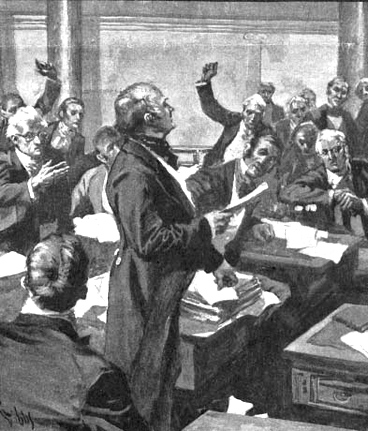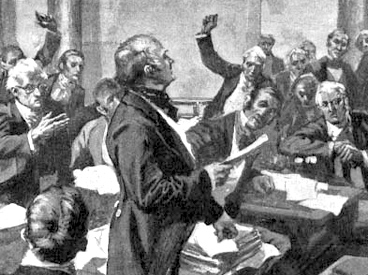 Maybe we should blame Frank Capra. Or blame his fictional creation, Jefferson Smith. In Capra’s movie Mr. Smith Goes To Washington, the idealistic young senator single-handedly blocks a corrupt law in the Senate by talking nonstop for 24 hours. The movie puts Senate filibustering in such a flattering light that many Americans regard the practice as a valuable, if quirky, protector of our liberties. Without that image of a lone senator holding up all business in the U. S. Senate as long as he continues talking, Americans might have demanded the Senate abandon this archaic practice.
Maybe we should blame Frank Capra. Or blame his fictional creation, Jefferson Smith. In Capra’s movie Mr. Smith Goes To Washington, the idealistic young senator single-handedly blocks a corrupt law in the Senate by talking nonstop for 24 hours. The movie puts Senate filibustering in such a flattering light that many Americans regard the practice as a valuable, if quirky, protector of our liberties. Without that image of a lone senator holding up all business in the U. S. Senate as long as he continues talking, Americans might have demanded the Senate abandon this archaic practice.
In recent months, there has been a sharp increase in filibustering. Republican senators have used the filibuster to block the appointment of federal judges and cabinet members, and oppose the use of surveillance drones in the U.S. What was once a last resort is becoming the rule, and Senate business has nearly ground to a halt.
Some Democratic senators say it’s time to reform Senate rules and curb the dependency on the filibuster. But as you can see in “Reform Of The Senate Rules,” people have been saying the same thing for at least 88 years.
The article was written back in 1926, when it was the Democrats who were filibustering. Vice President Charles Dawes warned Americans that the filibusters worked an “evil influence” over the county’s laws.
He believed the filibuster made it impossible to seriously consider lawmaking. He asked readers to imagine they were in a group that had to discuss and act on an important matter. However, “in this meeting any one of us may talk as long as he pleases, whether relevant to the subject we are considering or not. If anyone desires he may use up all the time we have at our disposal, even if he has the purpose of depriving us as a body of the right to act.”
Such an arrangement would be met with “scorn and derision,” except in the U.S. Senate. By permitting the right of unlimited debate, he wrote, “it has surrendered to the whim and personal purpose of individuals and minorities.”
Filibusters, he added, caused delays in business so that other bills couldn’t be properly debated. Generally they didn’t defeat legislation but pressured the senators to change laws shaped by public interest to favor personal and sectional interests. The result of all these amendments, Dawes says, is a spiraling increase in the number of laws.
Of course, the Senate has always had the means to end filibusters. If enough senators vote for cloture, the filibusterer has to yield. In Dawes’ time, cloture required the approval of two-thirds of the senate’s 96 members. Because of the difficulty in obtaining the consent needed, Dawes wrote, “the Senate has amended the Constitution as to make it possible for a 33 per cent minority to block legislation.” He proposed that cloture votes require a simple majority: 51 percent instead of 66 percent.
Today, the rules for ending filibusters are slightly easier. A cloture vote can be carried by three-fifths of the members. But it’s hard to get 60 senators to agree in a Senate polarized between 53 Democrats and 45 Republicans.
Will the current move to reform the filibuster rules be successful? There are two reasons why it’s unlikely. First, changing Senate rules would take the approval of 66 senators at a time when it seems impossible even to get agreement among 60. Second, there are the practical considerations of politics: filibusters can work for either party. The Democrats may find the filibuster very convenient when they are next in the Senate minority.
In the meantime, though, senators will continue talking about the need to reform the rules. And Americans will keep hoping to see a new Senator Smith stage a solitary fight on the Senate floor.
Become a Saturday Evening Post member and enjoy unlimited access. Subscribe now



